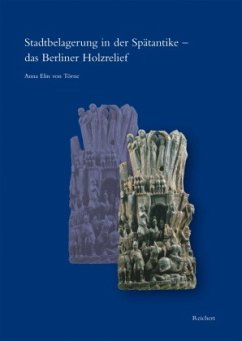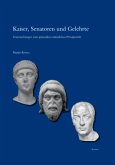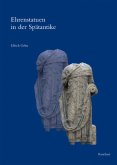Since the first publication about it in 1901, this unique wooden relief has been attributed to the Coptic maker because it was discovered in Egypt. The precise meaning of its richly detailed and impressive imagery, however, had remained shrouded in obscurity. The iconographic and stylistic analysis contained in this volume draws on comparative studies of material artifacts to reveal that the wooden relief belongs to Western Roman art of the fifth century. The relief portrays the suppression of the usurpation of John and his Hunnic cavalry troops outside the city gates of Ravenna by the Roman legionaries of Galla Placidia in the summer of 425 A.D. This historical revision places the relief in a new research context.
Hinweis: Dieser Artikel kann nur an eine deutsche Lieferadresse ausgeliefert werden.
Hinweis: Dieser Artikel kann nur an eine deutsche Lieferadresse ausgeliefert werden.
"Eine Zusammenfassung (137-139), ein Anhang mit zeichnerischen Rekonstruktionen (gut! 143-148) sowie ein Abkürzungsverzeichnis und eine Bibliographie (149-179), Abbildungsverzeichnis und ein guter Tafelteil (20 Taf.) beschließen das Buch. T. hat mit diesem Erstlingswerk (...) ein interessantes Buch zu einem Denkmal abgeliefert, das in der Tat viele Fragen aufwirft. Viele davon hat T. zu erklären versucht, andere ganz neu und sicher völlig zu Recht formuliert oder neu moduliert. Verdienstvolle, auch innovative Ansätze sind in jedem Fall erkennbar. Nicht immer ist die Suche nach Antworten auf die gestellten Fragen befriedigend gewesen - aber, eines ist sicher, T. hat eine Grundlage geschafften, auf der sich über dieses berühmte Relief nun trefflich weiter diskutieren lässt!"
Oliver Stoll
In: Gymnasium. 119 (2012) Heft 3. S. 308-311.
------------------------------------
"Von Törne's major contribution is to look beyond the relief's alleged Egyptian provenance. She demonstrates convincingly (pp. 76-87) that the style of the relief does not follow in the Coptic tradition, but rather has its closest parallels in the 5th century ivory diptychs of the western empire, in sarcophagi produced at Ravenna, and on the pedestal of Theodosius' Obelisk at Constantinople."
Martin Beckmann
In: Göttinger Forum für Altertumswissenschaft. 14 (2011). S. 1053-1055.
http://gfa.gbv.de/dr,gfa,014,2011,r,08.pdf
(4. August 2011)
Oliver Stoll
In: Gymnasium. 119 (2012) Heft 3. S. 308-311.
------------------------------------
"Von Törne's major contribution is to look beyond the relief's alleged Egyptian provenance. She demonstrates convincingly (pp. 76-87) that the style of the relief does not follow in the Coptic tradition, but rather has its closest parallels in the 5th century ivory diptychs of the western empire, in sarcophagi produced at Ravenna, and on the pedestal of Theodosius' Obelisk at Constantinople."
Martin Beckmann
In: Göttinger Forum für Altertumswissenschaft. 14 (2011). S. 1053-1055.
http://gfa.gbv.de/dr,gfa,014,2011,r,08.pdf
(4. August 2011)








